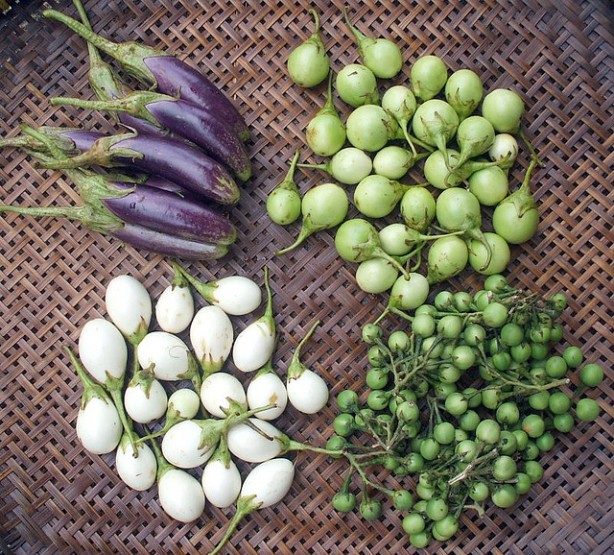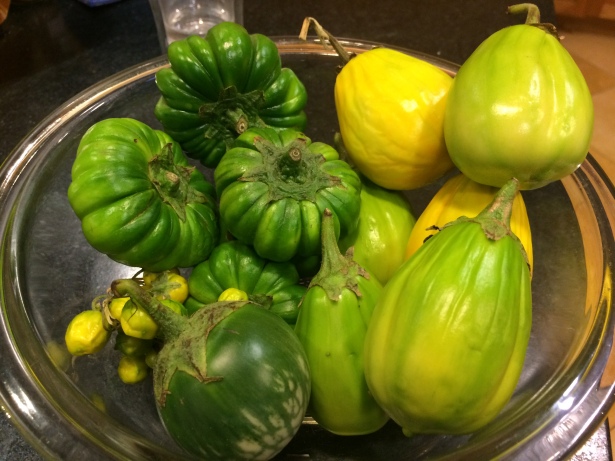Writing the eggplant post last week left me in a quandary. Since I live in the US, calling it eggplant seems natural. But then all through my childhood I called it baingan in Hindi and brinjal in English. Some of my readers from the UK will probably want to call it aubergine, while Australians, I hear, prefer the term egg fruit. [Update, 3/22: no, from comments, turns out they call it eggplant too.]
United by a common language indeed!
Well it turns out that the names of this humble vegetable have come about through a global game of Telephone (Chinese Whispers in India) involving empires and migrations of peoples. Sometimes the names have gone around the world and even come back to the source, changed, to go another round.
Intriguing.
![Wight, R., Illustrations of Indian botany, or figures illustrative of each of the natural orders of Indian plants, vol. 2: t. 166 (1850) [Goovindo] (Source: http://plantillustrations.org)](https://theoddpantry.files.wordpress.com/2015/03/45068.jpg?w=615&h=900)
Wight, R., Illustrations of Indian botany, or figures illustrative of each of the natural orders of Indian plants, vol. 2: t. 166 (1850) [Goovindo] (Source: http://plantillustrations.org)
The later arrivals to India, the Dravidian-speakers and the Sanskrit speakers, based their words for local vegetables on the original Munda words. The Munda word for eggplant survives as echoes in the Sanskrit vrintaka. In fact, they must have known that the tomato and the eggplant are both from the nightshade family, because the eggplant was known as ‘kanta vrintaka‘ while tomatoes were known as ‘rakta vrintaka‘ — presumably, spiny nightshade and blood nightshade respectively.
Another Sanskrit name that eggplant was given was ‘vatingan‘ which comes from its abilities to remove gas (=wind gone, or, more pointedly, fart gone). This word became the ancestor of a number of words used all over India:
- Hindi: baingan
- Kannada: badne kai (‘kai’ = vegetable)
- Telugu: vankaya
- Bengali: begun
- Marathi: vangi
- Sindhi: vangan
Interesting. I love eggplant, but I’ve never thought of it as a substitute for Gas-X. Perhaps I should.
Meanwhile, still in the cloudy ancient past, Persian cooks caught wind of it also. There the Sanskrit word vatingan became transformed into badenjan. Iranian dialects still have a range of similar words for eggplant, showing its ancestry: from the Encyclopedia Iranica, we have badengan, patlejan, vangun (similar to Sindhi) and vayemjun. In Afghanistan, smack in the middle, the word is bademjan.
Now remember that eggplant is a member of the nightshade family, famed producer of toxins (for instance tobacco with nicotine, chilies with capsaicin). And by this point eggplant hadn’t had the track record in cultivation to have the toxins bred out of it. So some of the writings on this vegetable from those ancient days are filled with warnings. Persian writers from the Middle Ages blame eggplant for all kinds of ills from leprosy to the mysterious black bile.
But then, they went on to say, salting it removed those toxins, turning it beneficial, and neutralizing the bile. Could that advice be the reason that we in the modern age of the cultivated, toxin-free eggplant, continue to salt it like dolts? Sorry, I meant to say, the Persian scholars have been hugely influential in our current cuisine.
By getting the Persian cooks interested, eggplant hit the big time. The Persian lands were conquered by the Arabs in the seventh century. As food historian Rachel Laudan recounts in this essay, from the eighth century on, as the Islamic empire flourished in Baghdad, their chefs adapted Persian cuisine and spread it to their newly conquered capitals. They conquered Spain across the Mediterranean, and took the eggplant with them. The Arabs called it al-badinjan from the Persian, prefixing it with the Arabic definite article ‘al’. The Spanish dropped the ‘al’, and called it berenjena, as did the Portuguese, with their beringela. But Catalan kept the ‘al’, so eggplant became alberginia.
Now the French, nestled close to the Catalan lands, picked up this vegetable and also this word, but they had difficulty with the ‘al-‘ prefix, and rendered the word as aubergine. This word continues to be used today in France as well as England.
Interestingly, the Persian word for eggplant spread to Europe through two independent routes. West of the Mediterranean, it went to Spain and eventually France as aubergine. But east of the Mediterranean, the Arab conquest of Iran took it to Turkey, then to Greece, Italy and Eastern Europe. From the Encyclopedia Iranica again, “the spread of the word bādenjān can be traced in the Eastern Turkish patingen, Turkish and Russian patinjan, Georgian badnjan, Astrakhan Tatar badarjan or badijan.”
From that to Greek melitzana, and Latin melongena. Latin being a mother language in its own right, its word for eggplant became another fount of creativity. Linnaes picked it up to give its botanical name: Solanum melongena. Italian still uses the melanzana from the Latin. In fact just the other night I had some delicious melanzane alla Parmigiana. The English picked this up, briefly, as melongene, eventually to drop it in favor of aubergine. But they used that word long enough to bequeath it to Caribbean English as meloongen, as it is still used today.
Still with me? The insanity is not over yet, in fact, it is just beginning. Some in England heard the Latin melongena and took it to be mala insana — mad apple.
Mad Apple? We are a long way from Fart Gone. Are we still talking about Egg Plant? Yes.
As a matter of fact, the Old Foodie website quotes what seems to be the source of this mistranslation to ‘mad apple’ — a treatise known as Botanologia, the English herbal, or, History of plants (1710) by William Salmon. The English didn’t just mishear and corrupt melongena as mad apple. They also corrupted Badenjan to Brevun Jains, and the Portuguese beringela to Brown Jolly. It is still known as brown jolly today in the West Indies.

Four kinds of eggplants (source: https://www.flickr.com/photos/thai-food-blog/ on Flickr under Creative Commons License)
Now by this point the English were quite peripatetic themselves; rather than sitting in place waiting for fruits to land on their shores, they were out colonizing and bringing back botanical curiosities to grow at home. They had already become acquainted with eggplant through this route, and grew it as an ornamental. In the sixteenth century, it got described by an English herbalist known as John Gerard as ‘having the bignesse of a Swans egge’. This is probably the source of its current name, eggplant.
However, at this point the English did not consider it food, being from the nightshade family; just like Persian scholars from a thousand years ago, they warned of its propensity to cause disease, everything from cancer to piles to bad breath. ‘Doubtlesse these Apples have a mischevous qualitie,” John Gerard wrote, “It is therefore better to esteem this plant and have it in the garden for your pleasure and the rarenesse thereof, than for any virtue or good qualities yet knowne.’
This name, eggplant, is the one that the English took with them to America and Australia. It must be that they finally learned to enjoy it as food from the French, hence their word for it came from the French also — the elegant aubergine. (There are other examples of this Frenchification of food words: for instance, the English have a perfectly decent word that means ‘cow’ — it is, ‘cow’. But when they used the cow as food, they called it ‘beef’ from the French ‘boeuf’.)
Now, we are ready to come full circle, where I began, and where we began, back to India. The Portuguese colonized India in the sixteenth century, and brought their beringela back home. Either the Indians, or the later colonizers, the English, turned this into brinjal. This is the word that still survives today, as an English word, in India, Malaysia, and elsewhere. We think of this as an English word, but none of the English-speaking countries actually use it.
Notes: Eggplant was actually domesticated in China very early as well, in 500 BC; but I did not cover its trajectory through those lands, mostly because I lack familiarity with the languages. Also, I linked to my sources throughout, and my information is only as good as theirs is.
Hungry for more eggplant names? Here you go. Not satisfied? What’s it going to take? Here you go.
Tl;dr? Here you go.






That’s a really good read and very informative post… 😊
LikeLike
Thanks, glad you enjoyed it!
LikeLike
This has been very informative and interesting. I have long wondered where my family’s word for aubergine came from, and whilst I still don’t have an exact answer, I can fill in enough blanks to get a picture. For reference, my family descend from Indian immigrants to the Caribbean, settling in Saint Vincent and the Grenadines, you get a real mixed population on that island, but we’ve always called it a word that sounds like “balanjay”. I’ve never seen it written down so can only spell it out.
LikeLike
Fantastic read!!!
LikeLike
I love the idea of calling them Mad Apples, although it’s not a name I’ve heard before 🙂
LikeLike
some of these names come and go….
LikeLike
Wow! What’s in a name right? 🙂
LikeLike
A lot, apparently!
LikeLiked by 1 person
loved it
LikeLike
Thanks Lata and thanks for your contributions on FB!
LikeLike
Not egg fruit, eggplant here in Australia 🙂
LikeLike
Ah interesting! So part of my information was incorrect 🙂 Thanks!
LikeLiked by 1 person
Very cool chart! Loved this article. Now onto to the market to get some of these “kai”s 🙂
LikeLike
Let me know what kais you got and what you did with them…
LikeLike
Definitely eggplant in Australia, but incredibly versatile and delicious whatever language you name it in
LikeLike
Completely true. Nice to see you, Sandra!
LikeLiked by 1 person
A great post–I’ve always wondered about the history of eggplant. I’m reblogging this for my readers, too–thanks!
LikeLike
Thanks so much! Must spread the legend of the brinjal….
LikeLike
Reblogged this on A Single Serving and commented:
I’ve always wondered about all the different names and wide use of eggplant. Here is a great post to answer some of those questions.
LikeLike
Fabulous post – full of great information. My linguistic minded husband really enjoyed the word chart. But, where is the English “aubergine”? Yes, I know, from the French, but it is what the veg is called here in the UK.
LikeLike
Wow I’m not stepping into the English-French rivalry.You are right, I will have to add the English aubergine next derived from the French aubergine…
LikeLiked by 1 person
PS. I do mention that as a fact though, in the second to last para.
LikeLike
I know. I was being cheeky! Really loved the whole essay on eggplant.
LikeLike
It’s all intriguing isn’t it. I’ve just written a post about eggplant parmigiana on my blog and was interested to know that so many people get the origins of the dish wrong (including Jamie Oliver). My post here: https://ambradambra.wordpress.com/2015/03/31/eggplant-parmigiana-sophias-choice/
LikeLike
In Guyana they are called boulangie. I have no idea why. Perhaps somebody could tell me.
LikeLike
Ian, great question. So far I can find no information on this. Do you know what language family this is based on? It sounds like it derives from Latin, I wonder if that is true.
LikeLike
“boulangie” will presumably be another version of badenjan, berenjena, etc.
You mention similar words being used for aubergine/eggplant/etc and tomatoes by aboriginal speakers in parts of India, but they must have created the tomato term much later since tomatoes only left central America 400 or so years ago.
LikeLike
You are right. I’ll look this up again to see how I got this wrong. Thanks!
LikeLike
In malay or Indonesian it is ‘terong’. Do not how that came about!
LikeLike
That’s so funny, that looks almost exactly how my family from St Vincent and the Grenadines pronounce them. I’ve never seen it written before. It is all so interesting.
LikeLike
Discovered this (almost four years after it was posted) when a family dinner conversation veered into “why on earth do Americans call aubergines ‘eggplant’?” territory. (We’re Franco-Irish, so doubly ‘aubergine’-centric.) Fascinating story, wonderfully told. Thank you.
LikeLike
Thank you for reading. Plenty of other fruits and vegetables hide such treasures in their names.
LikeLike
There’s a beautiful (north)west-(south)east split in German:
– Germany/Switzerland: Aubergine
– Austria: Melanzani
On a map: http://www.atlas-alltagssprache.de/r10-f3k/
And apparently, there’s a tiny corner in Germany with “Eierfrucht” (egg fruit) as well, which I’ve never encountered.
LikeLike
Fascinating. Thanks for sharing.
LikeLike
And in English-speaking West Africa, ‘garden egg’. As you might guess, a lot of the varieties there are small and white.
Also, especially in Liberia, ‘bitter ball’. These are small and bitter, and probably much closer to the original vegetable, but Loveland love them.
LikeLike
That should have said LIBERIANS love them.
LikeLike
“Bitter ball” is a new one. It might even be my favorite! Thanks for the info.
LikeLike